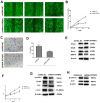GTPBP2 positively regulates the invasion, migration and proliferation of non-small cell lung cancer
- PMID: 34093790
- PMCID: PMC8176249
- DOI: 10.7150/jca.48340
GTPBP2 positively regulates the invasion, migration and proliferation of non-small cell lung cancer
Abstract
Lung cancer is one of the most common malignant tumors in the world, and the mortality rate ranks first among various malignant tumors. GTP-binding proteins (guanosine 5'-triphosphate-binding proteins, GTPBPs) are a type of protein with signal transduction function, have GTP hydrolase activity, and play an important role in cell signal transmission, cytoskeletal regulation, protein synthesis and other activities. GTPBP2 is one of the members of the G protein superfamily. Research on GTPBP2 is currently focused on human genetics, and its research in tumors has not been reported. First, Western blot and quantitative real-time PCR were used to analyze the expression differences of 12 cases of GTPBP2 in human NSCLC fresh cancer tissues and adjacent tissues. Then we selected 112 cases of NSCLC cancer tissues and 65 adjacent tissues for immunohistochemistry experiments to analyze the relationships between the expression of GTPBP2 and clinical pathological parameters and prognosis, we found that GTPBP2 is highly expressed in NSCLC cancer tissues, and the high expression of GTPBP2 is related to pTNM stage and lymph node metastasis. In addition, after GTPBP2 knockdown, GTPBP2 can promote the proliferation and invasion of NSCLC cell lines by up-regulating RhoC and MMP-9, and up-regulate cyclinD1, CDK4 and c-myc, and down-regulate P27 to promote the invasion of NSCLC cell lines. In addition, GTPBP2 negatively regulates Axin to promote β-catenin expression, thereby activating Wnt/β-catenin signaling, and promoting the occurrence of NSCLC.
Keywords: GTPBP2; cell invasion; cell migration; cell proliferation; non-small cell lung cancer..
© The author(s).
Conflict of interest statement
Competing Interests: The authors have declared that no competing interest exists.
Figures



Similar articles
-
Gtpbp2 is a positive regulator of Wnt signaling and maintains low levels of the Wnt negative regulator Axin.Cell Commun Signal. 2016 Aug 2;14(1):15. doi: 10.1186/s12964-016-0138-x. Cell Commun Signal. 2016. PMID: 27484226 Free PMC article.
-
GTP binding protein 2 maintains the quiescence, self-renewal, and chemoresistance of mouse colorectal cancer stem cells via promoting Wnt signaling activation.Heliyon. 2024 Mar 1;10(5):e27159. doi: 10.1016/j.heliyon.2024.e27159. eCollection 2024 Mar 15. Heliyon. 2024. PMID: 38468952 Free PMC article.
-
Downregulation of N-Acetylglucosaminyltransferase GCNT3 by miR-302b-3p Decreases Non-Small Cell Lung Cancer (NSCLC) Cell Proliferation, Migration and Invasion.Cell Physiol Biochem. 2018;50(3):987-1004. doi: 10.1159/000494482. Epub 2018 Oct 24. Cell Physiol Biochem. 2018. PMID: 30355927
-
Knockdown of HJURP inhibits non-small cell lung cancer cell proliferation, migration, and invasion by repressing Wnt/β-catenin signaling.Eur Rev Med Pharmacol Sci. 2019 May;23(9):3847-3856. doi: 10.26355/eurrev_201905_17812. Eur Rev Med Pharmacol Sci. 2019. PMID: 31115012
-
Clinical delineation of GTPBP2-associated neuro-ectodermal syndrome: Report of two new families and review of the literature.Clin Genet. 2019 May;95(5):601-606. doi: 10.1111/cge.13523. Epub 2019 Mar 19. Clin Genet. 2019. PMID: 30790272 Review.
Cited by
-
Organ and cell-specific biomarkers of Long-COVID identified with targeted proteomics and machine learning.Mol Med. 2023 Feb 21;29(1):26. doi: 10.1186/s10020-023-00610-z. Mol Med. 2023. PMID: 36809921 Free PMC article.
-
Wnt/β-catenin signaling in the development and therapeutic resistance of non-small cell lung cancer.J Transl Med. 2024 Jun 13;22(1):565. doi: 10.1186/s12967-024-05380-8. J Transl Med. 2024. PMID: 38872189 Free PMC article. Review.
-
A network-based transcriptomic landscape of HepG2 cells uncovering causal gene-cytotoxicity interactions underlying drug-induced liver injury.Toxicol Sci. 2024 Feb 28;198(1):14-30. doi: 10.1093/toxsci/kfad121. Toxicol Sci. 2024. PMID: 38015832 Free PMC article.
-
GTPBP2 in-frame deletion in canine model with non-syndromic progressive retinal atrophy.Sci Rep. 2025 Feb 19;15(1):6079. doi: 10.1038/s41598-025-89446-7. Sci Rep. 2025. PMID: 39971978 Free PMC article.
-
The Role of Purine Metabolism-Related Genes PPAT and IMPDH1 in the Carcinogenesis of Intrahepatic Cholangiocarcinoma Based on Metabonomic and Bioinformatic Analyses.J Oncol. 2023 Jan 20;2023:5141836. doi: 10.1155/2023/5141836. eCollection 2023. J Oncol. 2023. PMID: 36711025 Free PMC article.
References
-
- Bray F, Ferlay J, Soerjomataram I, Siegel RL, Torre LA, Jemal A. Global cancer statistics 2018: GLOBOCAN estimates of incidence and mortality worldwide for 36 cancers in 185 countries. CA Cancer J Clin. 2018;68(6):394–424. - PubMed
-
- Watanabe M, Yoshida K, Hida M, Kato H, Uchida K, Yamaguchi R. et al. Cloning, expression analysis, and chromosomal mapping of GTPBP2, a novel member of the G protein family. Gene. 2000;256(1-2):51–58. - PubMed
-
- Kudo H, Senju S, Mitsuya H, Nishimura Y. Mouse and human GTPBP2, newly identified members of the GP-1 family of GTPase. Biochem Biophys Res Commun. 2000;272(2):456–65. - PubMed
-
- Carter MT, Venkateswaran S, Shapira-Zaltsberg G, Davila J, Humphreys P, Kernohan KD. et al. Clinical delineation of GTPBP2-associated neuro-ectodermal syndrome: Report of two new families and review of the literature. Clin Genet. 2019;95(5):601–6. - PubMed
LinkOut - more resources
Full Text Sources
Miscellaneous

